Abstract
Activation of the complement system was studied in baboons that were challenged with live Escherichia coli. In the group challenged with a lethal dose (n = 4), the complement activation parameters C3b/c, C4b/c, and C5b-9 increased 13, 5, and 12 times the baseline value, respectively, during the first 6 h after the E. coli infusion, whereas in the group challenged with a sublethal dose (n = 10), they increased only moderately, by 2 to 3 times the baseline value. However, in this latter group, a more pronounced activation occurred at 24 h. Subsequent experiments showed that this second phase in complement activation started at 6 h after the challenge, at which time infused microorganisms had been cleared from the circulation. The simultaneous increase in C-reactive protein with this second phase suggested an endogenous activation mechanism involving this acute-phase protein. Levels of inactivated (modified) C1 inhibitor also increased in both groups, with peak levels of 2.5 times the baseline value at 24 h in the sublethal group and of 4 times at 6 h after the challenge in the lethal group. Thus, activation of complement in this animal model for sepsis occurs in a biphasic pattern, the initial phase mediated by the bacteria and the later phase mediated by an endogenous mechanism possibly involving C-reactive protein. The differences in complement activation between animals with lethal or sublethal sepsis support the hypothesis that complement activation contributes to the lethal complications of sepsis.
Full text
PDF
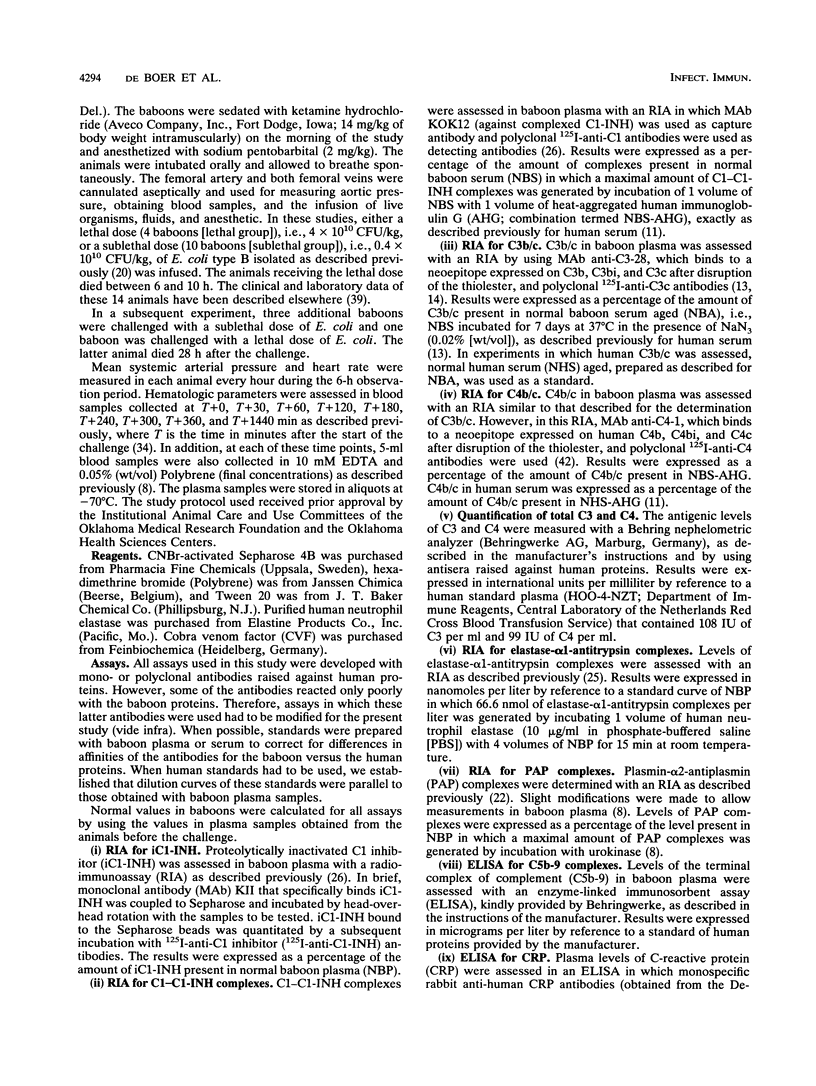


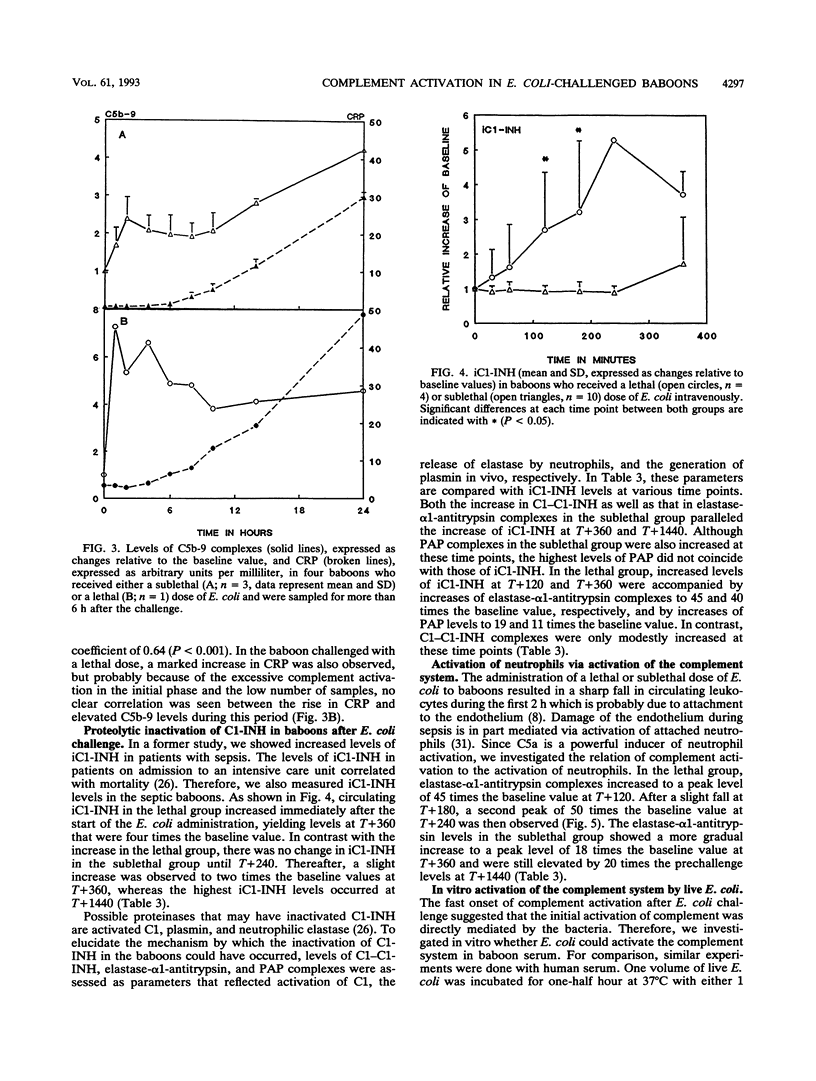
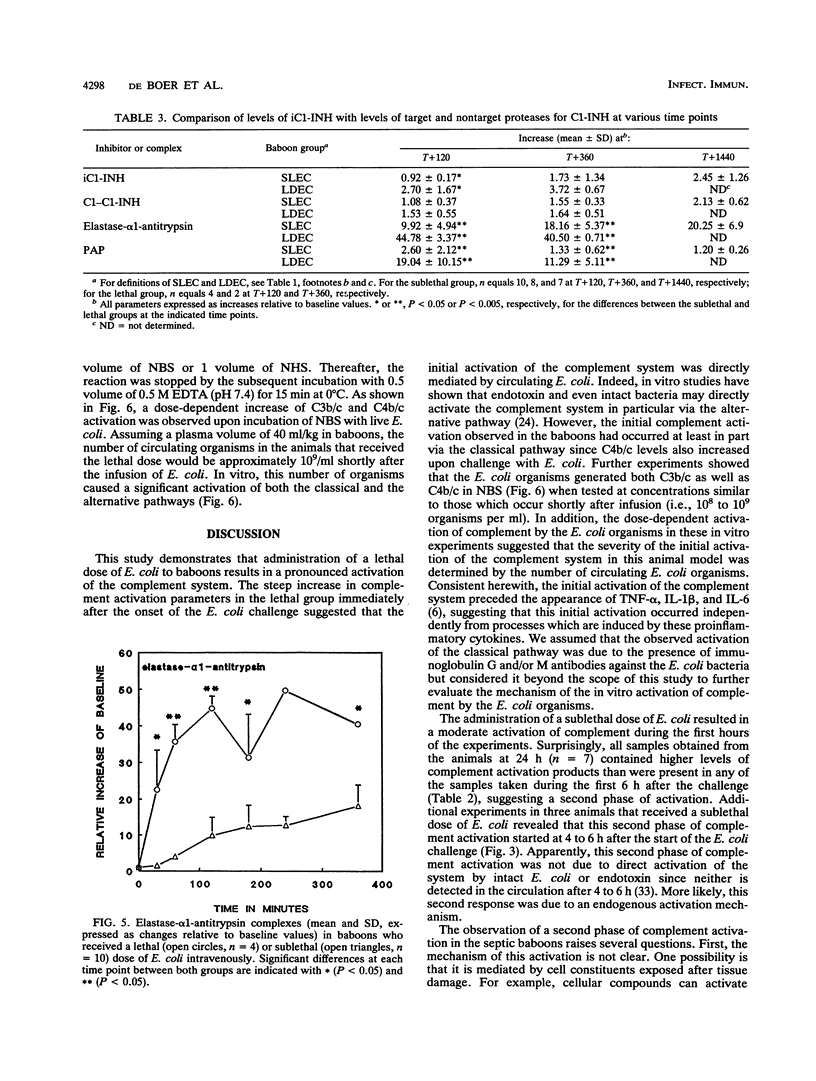
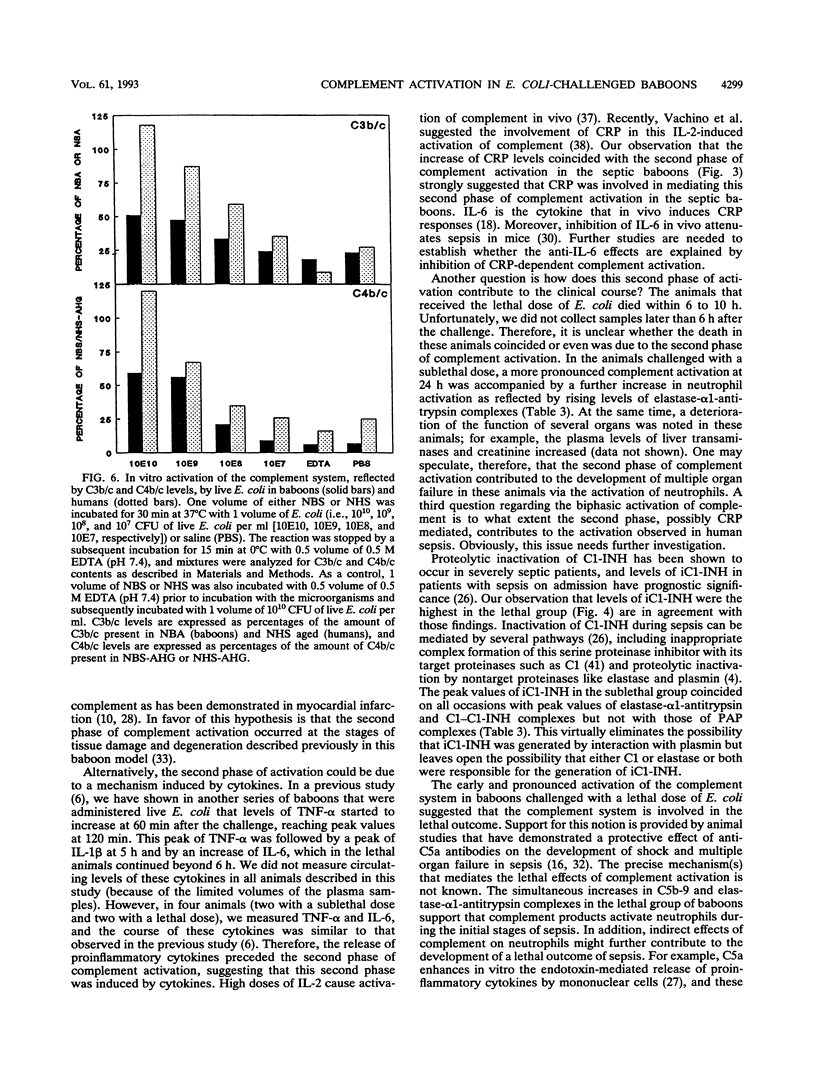
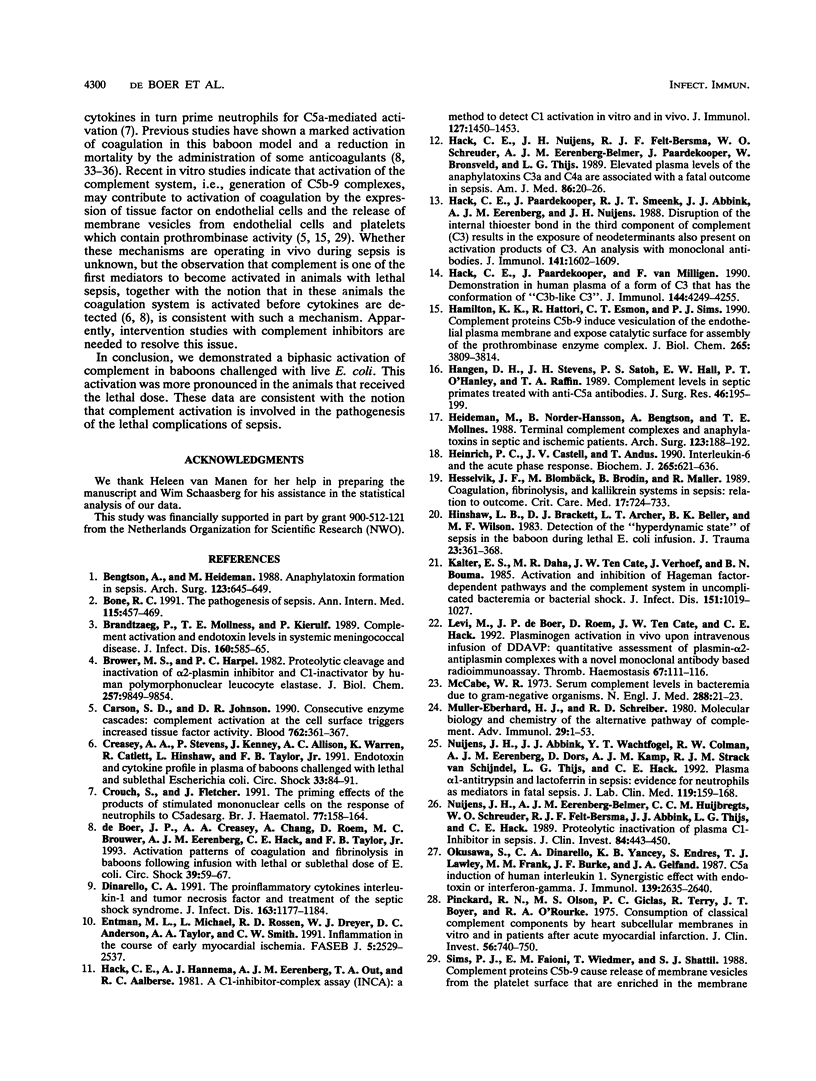
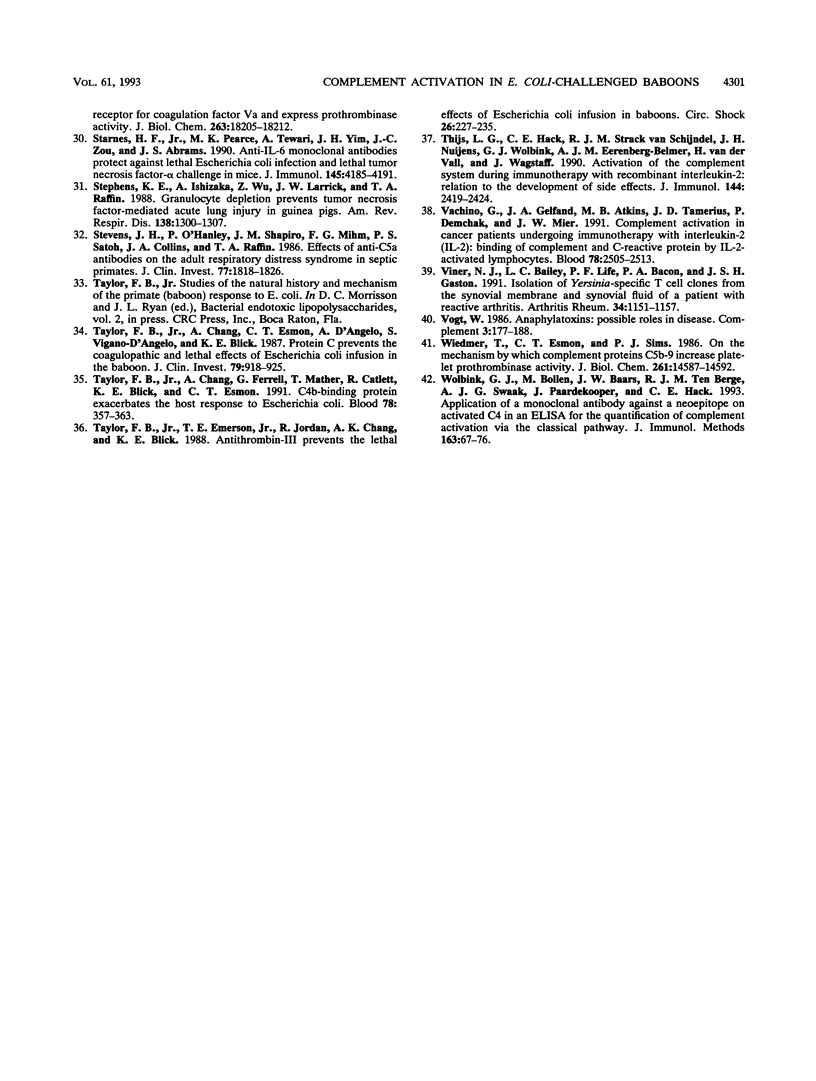
Selected References
These references are in PubMed. This may not be the complete list of references from this article.
- Bengtson A., Heideman M. Anaphylatoxin formation in sepsis. Arch Surg. 1988 May;123(5):645–649. doi: 10.1001/archsurg.1988.01400290131023. [DOI] [PubMed] [Google Scholar]
- Bone R. C. The pathogenesis of sepsis. Ann Intern Med. 1991 Sep 15;115(6):457–469. doi: 10.7326/0003-4819-115-6-457. [DOI] [PubMed] [Google Scholar]
- Brandtzaeg P., Mollnes T. E., Kierulf P. Complement activation and endotoxin levels in systemic meningococcal disease. J Infect Dis. 1989 Jul;160(1):58–65. doi: 10.1093/infdis/160.1.58. [DOI] [PubMed] [Google Scholar]
- Brower M. S., Harpel P. C. Proteolytic cleavage and inactivation of alpha 2-plasmin inhibitor and C1 inactivator by human polymorphonuclear leukocyte elastase. J Biol Chem. 1982 Aug 25;257(16):9849–9854. [PubMed] [Google Scholar]
- Carson S. D., Johnson D. R. Consecutive enzyme cascades: complement activation at the cell surface triggers increased tissue factor activity. Blood. 1990 Jul 15;76(2):361–367. [PubMed] [Google Scholar]
- Creasey A. A., Stevens P., Kenney J., Allison A. C., Warren K., Catlett R., Hinshaw L., Taylor F. B., Jr Endotoxin and cytokine profile in plasma of baboons challenged with lethal and sublethal Escherichia coli. Circ Shock. 1991 Feb;33(2):84–91. [PubMed] [Google Scholar]
- Crouch S., Fletcher J. The priming effects of the products of stimulated mononuclear cells on the response of neutrophils to C5a des arg. Br J Haematol. 1991 Feb;77(2):158–164. doi: 10.1111/j.1365-2141.1991.tb07971.x. [DOI] [PubMed] [Google Scholar]
- Dinarello C. A. The proinflammatory cytokines interleukin-1 and tumor necrosis factor and treatment of the septic shock syndrome. J Infect Dis. 1991 Jun;163(6):1177–1184. doi: 10.1093/infdis/163.6.1177. [DOI] [PubMed] [Google Scholar]
- Entman M. L., Michael L., Rossen R. D., Dreyer W. J., Anderson D. C., Taylor A. A., Smith C. W. Inflammation in the course of early myocardial ischemia. FASEB J. 1991 Aug;5(11):2529–2537. doi: 10.1096/fasebj.5.11.1868978. [DOI] [PubMed] [Google Scholar]
- Hack C. E., Hannema A. J., Eerenberg-Belmer A. J., Out T. A., Aalberse R. C. A C1-inhibitor-complex assay (INCA): a method to detect C1 activation in vitro and in vivo. J Immunol. 1981 Oct;127(4):1450–1453. [PubMed] [Google Scholar]
- Hack C. E., Nuijens J. H., Felt-Bersma R. J., Schreuder W. O., Eerenberg-Belmer A. J., Paardekooper J., Bronsveld W., Thijs L. G. Elevated plasma levels of the anaphylatoxins C3a and C4a are associated with a fatal outcome in sepsis. Am J Med. 1989 Jan;86(1):20–26. doi: 10.1016/0002-9343(89)90224-6. [DOI] [PubMed] [Google Scholar]
- Hack C. E., Paardekooper J., Smeenk R. J., Abbink J., Eerenberg A. J., Nuijens J. H. Disruption of the internal thioester bond in the third component of complement (C3) results in the exposure of neodeterminants also present on activation products of C3. An analysis with monoclonal antibodies. J Immunol. 1988 Sep 1;141(5):1602–1609. [PubMed] [Google Scholar]
- Hack C. E., Paardekooper J., Van Milligen F. Demonstration in human plasma of a form of C3 that has the conformation of "C3b-like C3". J Immunol. 1990 Jun 1;144(11):4249–4255. [PubMed] [Google Scholar]
- Hamilton K. K., Hattori R., Esmon C. T., Sims P. J. Complement proteins C5b-9 induce vesiculation of the endothelial plasma membrane and expose catalytic surface for assembly of the prothrombinase enzyme complex. J Biol Chem. 1990 Mar 5;265(7):3809–3814. [PubMed] [Google Scholar]
- Hangen D. H., Stevens J. H., Satoh P. S., Hall E. W., O'Hanley P. T., Raffin T. A. Complement levels in septic primates treated with anti-C5a antibodies. J Surg Res. 1989 Mar;46(3):195–199. doi: 10.1016/0022-4804(89)90055-3. [DOI] [PubMed] [Google Scholar]
- Heideman M., Norder-Hansson B., Bengtson A., Mollnes T. E. Terminal complement complexes and anaphylatoxins in septic and ischemic patients. Arch Surg. 1988 Feb;123(2):188–192. doi: 10.1001/archsurg.1988.01400260068008. [DOI] [PubMed] [Google Scholar]
- Heinrich P. C., Castell J. V., Andus T. Interleukin-6 and the acute phase response. Biochem J. 1990 Feb 1;265(3):621–636. doi: 10.1042/bj2650621. [DOI] [PMC free article] [PubMed] [Google Scholar]
- Hesselvik J. F., Blombäck M., Brodin B., Maller R. Coagulation, fibrinolysis, and kallikrein systems in sepsis: relation to outcome. Crit Care Med. 1989 Aug;17(8):724–733. doi: 10.1097/00003246-198908000-00002. [DOI] [PubMed] [Google Scholar]
- Hinshaw L. B., Brackett D. J., Archer L. T., Beller B. K., Wilson M. F. Detection of the 'hyperdynamic state' of sepsis in the baboon during lethal E. coli infusion. J Trauma. 1983 May;23(5):361–365. doi: 10.1097/00005373-198305000-00001. [DOI] [PubMed] [Google Scholar]
- Kalter E. S., Daha M. R., ten Cate J. W., Verhoef J., Bouma B. N. Activation and inhibition of Hageman factor-dependent pathways and the complement system in uncomplicated bacteremia or bacterial shock. J Infect Dis. 1985 Jun;151(6):1019–1027. doi: 10.1093/infdis/151.6.1019. [DOI] [PubMed] [Google Scholar]
- Levi M., de Boer J. P., Roem D., ten Cate J. W., Hack C. E. Plasminogen activation in vivo upon intravenous infusion of DDAVP. Quantitative assessment of plasmin-alpha 2-antiplasmin complex with a novel monoclonal antibody based radioimmunoassay. Thromb Haemost. 1992 Jan 23;67(1):111–116. [PubMed] [Google Scholar]
- McCabe W. R. Serum complement levels in bacteremia due to gram-negative organisms. N Engl J Med. 1973 Jan 4;288(1):21–23. doi: 10.1056/NEJM197301042880105. [DOI] [PubMed] [Google Scholar]
- Müller-Eberhard H. J., Schreiber R. D. Molecular biology and chemistry of the alternative pathway of complement. Adv Immunol. 1980;29:1–53. doi: 10.1016/s0065-2776(08)60042-5. [DOI] [PubMed] [Google Scholar]
- Nuijens J. H., Abbink J. J., Wachtfogel Y. T., Colman R. W., Eerenberg A. J., Dors D., Kamp A. J., Strack van Schijndel R. J., Thijs L. G., Hack C. E. Plasma elastase alpha 1-antitrypsin and lactoferrin in sepsis: evidence for neutrophils as mediators in fatal sepsis. J Lab Clin Med. 1992 Feb;119(2):159–168. [PubMed] [Google Scholar]
- Nuijens J. H., Eerenberg-Belmer A. J., Huijbregts C. C., Schreuder W. O., Felt-Bersma R. J., Abbink J. J., Thijs L. G., Hack C. E. Proteolytic inactivation of plasma C1- inhibitor in sepsis. J Clin Invest. 1989 Aug;84(2):443–450. doi: 10.1172/JCI114185. [DOI] [PMC free article] [PubMed] [Google Scholar]
- Okusawa S., Dinarello C. A., Yancey K. B., Endres S., Lawley T. J., Frank M. M., Burke J. F., Gelfand J. A. C5a induction of human interleukin 1. Synergistic effect with endotoxin or interferon-gamma. J Immunol. 1987 Oct 15;139(8):2635–2640. [PubMed] [Google Scholar]
- Pinckard R. N., Olson M. S., Giclas P. C., Terry R., Boyer J. T., O'Rourke R. A. Consumption of classical complement components by heart subcellular membranes in vitro and in patients after acute myocardial infarction. J Clin Invest. 1975 Sep;56(3):740–750. doi: 10.1172/JCI108145. [DOI] [PMC free article] [PubMed] [Google Scholar]
- Sims P. J., Faioni E. M., Wiedmer T., Shattil S. J. Complement proteins C5b-9 cause release of membrane vesicles from the platelet surface that are enriched in the membrane receptor for coagulation factor Va and express prothrombinase activity. J Biol Chem. 1988 Dec 5;263(34):18205–18212. [PubMed] [Google Scholar]
- Starnes H. F., Jr, Pearce M. K., Tewari A., Yim J. H., Zou J. C., Abrams J. S. Anti-IL-6 monoclonal antibodies protect against lethal Escherichia coli infection and lethal tumor necrosis factor-alpha challenge in mice. J Immunol. 1990 Dec 15;145(12):4185–4191. [PubMed] [Google Scholar]
- Stephens K. E., Ishizaka A., Wu Z. H., Larrick J. W., Raffin T. A. Granulocyte depletion prevents tumor necrosis factor-mediated acute lung injury in guinea pigs. Am Rev Respir Dis. 1988 Nov;138(5):1300–1307. doi: 10.1164/ajrccm/138.5.1300. [DOI] [PubMed] [Google Scholar]
- Taylor F. B., Jr, Chang A., Esmon C. T., D'Angelo A., Vigano-D'Angelo S., Blick K. E. Protein C prevents the coagulopathic and lethal effects of Escherichia coli infusion in the baboon. J Clin Invest. 1987 Mar;79(3):918–925. doi: 10.1172/JCI112902. [DOI] [PMC free article] [PubMed] [Google Scholar]
- Taylor F. B., Jr, Emerson T. E., Jr, Jordan R., Chang A. K., Blick K. E. Antithrombin-III prevents the lethal effects of Escherichia coli infusion in baboons. Circ Shock. 1988 Nov;26(3):227–235. [PubMed] [Google Scholar]
- Taylor F., Chang A., Ferrell G., Mather T., Catlett R., Blick K., Esmon C. T. C4b-binding protein exacerbates the host response to Escherichia coli. Blood. 1991 Jul 15;78(2):357–363. [PubMed] [Google Scholar]
- Thijs L. G., Hack C. E., Strack van Schijndel R. J., Nuijens J. H., Wolbink G. J., Eerenberg-Belmer A. J., Van der Vall H., Wagstaff J. Activation of the complement system during immunotherapy with recombinant IL-2. Relation to the development of side effects. J Immunol. 1990 Mar 15;144(6):2419–2424. [PubMed] [Google Scholar]
- Vachino G., Gelfand J. A., Atkins M. B., Tamerius J. D., Demchak P., Mier J. W. Complement activation in cancer patients undergoing immunotherapy with interleukin-2 (IL-2): binding of complement and C-reactive protein by IL-2-activated lymphocytes. Blood. 1991 Nov 15;78(10):2505–2513. [PubMed] [Google Scholar]
- Viner N. J., Bailey L. C., Life P. F., Bacon P. A., Gaston J. S. Isolation of Yersinia-specific T cell clones from the synovial membrane and synovial fluid of a patient with reactive arthritis. Arthritis Rheum. 1991 Sep;34(9):1151–1157. doi: 10.1002/art.1780340911. [DOI] [PubMed] [Google Scholar]
- Vogt W. Anaphylatoxins: possible roles in disease. Complement. 1986;3(3):177–188. doi: 10.1159/000467894. [DOI] [PubMed] [Google Scholar]
- Wiedmer T., Esmon C. T., Sims P. J. On the mechanism by which complement proteins C5b-9 increase platelet prothrombinase activity. J Biol Chem. 1986 Nov 5;261(31):14587–14592. [PubMed] [Google Scholar]
- Wolbink G. J., Bollen J., Baars J. W., ten Berge R. J., Swaak A. J., Paardekooper J., Hack C. E. Application of a monoclonal antibody against a neoepitope on activated C4 in an ELISA for the quantification of complement activation via the classical pathway. J Immunol Methods. 1993 Jul 6;163(1):67–76. doi: 10.1016/0022-1759(93)90240-8. [DOI] [PubMed] [Google Scholar]
- de Boer J. P., Creasy A. A., Chang A., Roem D., Brouwer M. C., Eerenberg A. J., Hack C. E., Taylor F. B., Jr Activation patterns of coagulation and fibrinolysis in baboons following infusion with lethal or sublethal dose of Escherichia coli. Circ Shock. 1993 Jan;39(1):59–67. [PubMed] [Google Scholar]


